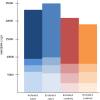High Levels of Epstein-Barr Virus Nuclear Antigen-1-Specific Antibodies and Infectious Mononucleosis Act Both Independently and Synergistically to Increase Multiple Sclerosis Risk
- PMID: 32038456
- PMCID: PMC6992610
- DOI: 10.3389/fneur.2019.01368
High Levels of Epstein-Barr Virus Nuclear Antigen-1-Specific Antibodies and Infectious Mononucleosis Act Both Independently and Synergistically to Increase Multiple Sclerosis Risk
Abstract
Objective: Elevated levels of anti-EBNA-1 antibodies and infectious mononucleosis (IM) history have consistently been associated with multiple sclerosis (MS) risk. We aimed to study whether these aspects of Epstein-Barr virus (EBV) infection represent separate risk factors for MS and whether they both interact with MS-associated HLA genes in disease development. Methods: Two Swedish-population-based case-control studies were used, comprising 5,316 cases and 5,431 matched controls. Subjects with different HLA alleles, EBNA-1, and IM status were compared regarding MS risk by calculating odds ratios (OR) with 95% confidence intervals (CI) employing logistic regression. Causal mediation analysis was used to assess to what extent the relationship between IM history and MS risk was mediated by high anti-EBNA-1 antibody levels and vice versa. Results: The causal mediation analysis revealed that both aspects of EBV infection mainly act directly on MS risk. The direct effect of elevated anti-EBNA-1 antibody levels on MS risk, expressed on the OR scale, was 2.8 (95% CI 2.5-3.1), and the direct effect of IM history on MS risk was 1.7 (95% CI 1.5-2.0). A significant interaction between the two aspects of EBV infection was observed (RERI 1.2, 95% CI 0.3-2.0), accounting for about 50% of the total effect. Further, both aspects of EBV infection interacted with DRB1*15:01 and absence of A*02:01. Interpretation: Elevated anti-EBNA-1 antibody levels and IM history are different risk factors for MS. The two aspects of EBV infection act synergistically to increase MS risk, indicating that they partly are involved in the same biological pathways.
Keywords: Epstein–Barr virus infection; anti-EBNA-1 antibodies; human leukocyte antigen; infectious mononucleosis; multiple sclerosis.
Copyright © 2020 Hedström, Huang, Michel, Butt, Brenner, Hillert, Waterboer, Kockum, Olsson and Alfredsson.
Figures
References
-
- International Multiple Sclerosis Genetics Consortium, Wellcome Trust case control consortium 2. Sawcer S, Hellenthal G, Pirinen M, Spencer CC, et al. . Genetic risk and a primary role for cell-mediated immune mechanisms in multiple sclerosis. Nature. (2011) 476:214–9. 10.1038/nature10251 - DOI - PMC - PubMed
LinkOut - more resources
Full Text Sources
Research Materials



